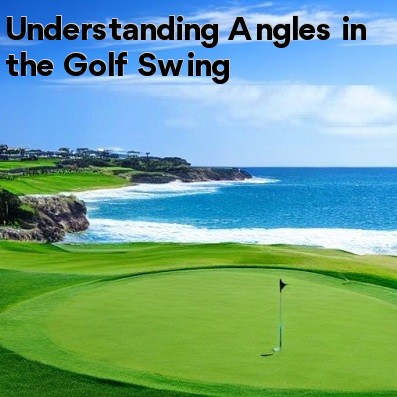
In golf, Understanding Angles in the Golf Swing
Golf is a game that requires precision and technique. One crucial aspect of the game is understanding and utilizing angles in the golf swing. By comprehending how angles affect the trajectory and flight of the ball, golfers can make more accurate shots and improve their overall performance on the course.
Grip Angle:
The grip is the foundation of a golfer's swing, and the angle at which the golfer holds the club can have a significant impact on the shot. The most common grip angle is a neutral grip, where the club is positioned squarely in the hands. However, some golfers prefer a stronger grip, where the club is rotated slightly towards the trail hand, or a weaker grip, where the club is rotated slightly towards the lead hand. Each grip angle affects the clubface's alignment at impact and can influence the ball's flight path.
The club path angle refers to the direction in which the clubhead is moving during the swing. This angle dictates the initial direction of the shot. If the club path angle is straight towards the target line, the shot will likely travel straight. However, if the club path angle is inside-out or outside-in, the shot will curve either to the left or right, respectively. Golfers often work on their club path angle to correct any undesirable shot shapes they may be experiencing.
Swing Plane Angle:
The swing plane angle is the angle in which the club travels during the swing. It is often represented by an imaginary line that runs through the club shaft. The swing plane angle can vary depending on a golfer's body type and swing style. Generally, a more upright swing plane angle produces a more vertical ball flight, while a flatter swing plane angle creates a lower, more horizontal ball flight. Golfers must find the swing plane angle that suits their game and helps them achieve their desired shot shape.
Launch Angle:
The launch angle is the angle at which the ball takes off from the clubface. It is influenced by several factors, including the club loft, ball position, and swing speed. A higher launch angle produces a higher ball flight, while a lower launch angle creates a lower ball flight. Golfers can adjust their launch angles by modifying their setup, such as teeing the ball higher or lower or adjusting their ball position in their stance.
Spin Angle:
Spin angle refers to the axis on which the ball spins. The spin axis is tilted depending on how the clubface contacts the ball at impact. A tilted spin axis creates side spin, which influences the ball's curvature in flight. Golfers who understand spin angle can manipulate their shots to curve intentionally. For example, a golfer can hit a fade by creating a spin axis that tilts to the left for a right-handed player or vice versa for a draw.
Update:
There are many angles involved in the golf swing, but some of the most important ones include:
- Shaft angle: The angle between the shaft of the club and the ground at address. This angle is important for creating a proper swing path and clubhead speed.
- Wrist angle: The angle between the clubshaft and the forearms at address. This angle is important for controlling the clubface and generating power.
- Hip angle: The angle between the hips and the ground at address. This angle is important for creating a stable base and transferring weight during the swing.
- Shoulder angle: The angle between the shoulders and the ground at address. This angle is important for creating a balanced swing and generating power.
- Spine angle: The angle between the spine and the ground at address. This angle is important for creating a repeatable swing and preventing injuries.
- Clubface angle: The angle between the clubface and the target line at impact. This angle is important for controlling the direction of the ball flight.
The ideal angles for these different parts of the swing will vary depending on the individual golfer's body type, swing style, and goals. However, it is important to maintain these angles throughout the swing in order to achieve a consistent and powerful swing.
Here are some tips for maintaining the correct angles in your golf swing:
- Get a proper grip. The grip is the foundation of the swing, so it is important to get it right.
- Make sure that you are properly aligned. This means that your feet, hips, and shoulders should be aligned parallel to the target line.
- Keep your head still throughout the swing. This will help you to maintain your balance and control the angles in your swing.
- Practice regularly. The more you practice, the better you will become at maintaining the correct angles in your swing.
By following these tips, you can improve your golf swing and start hitting the ball more consistently.
Conclusion:
Understanding angles in the golf swing is crucial for any golfer looking to improve their game. By analyzing and adjusting grip angle, club path angle, swing plane angle, launch angle, and spin angle, golfers can optimize their shots and improve their overall accuracy on the golf course. Experimenting with these angles and seeking guidance from golf professionals can lead to significant improvements in a golfer's performance and enjoyment of the game.
Q&A:
Q1: Why are angles important in the golf swing?
A: Angles play a crucial role in the golf swing as they determine the club's position and movement during different phases of the swing. Proper angles help generate power, accuracy, and consistency.
Q2: What are the key angles in the golf swing?
A: The key angles include the wrist hinge (cocking), shoulder rotation, hip rotation, and knee flexion. These angles work together to create a smooth and efficient swing.
Q3: How does wrist hinge impact the golf swing?
A: Wrist hinge, or cocking, occurs during the backswing when the wrists set the club at an angle. This angle stores energy and helps generate speed during the downswing.
Q4: What's the role of shoulder rotation in the swing?
A: Shoulder rotation controls the club's path and helps generate power. Proper shoulder rotation allows you to coil during the backswing and release during the downswing.
Q5: How does hip rotation contribute to the swing?
A: Hip rotation helps generate torque and transfer energy from the lower body to the upper body. It adds power and consistency to the swing.
Q6: Why is knee flexion important?
A: Knee flexion provides stability and balance during the swing. It helps maintain a solid base and allows for proper weight transfer.
Q7: How can I improve my understanding of angles in the swing?
A: Seek guidance from a golf instructor. Video analysis can provide insights into your angles. Practice drills and slow-motion swings can help you feel the correct angles.
Q8: Can I overemphasize angles in my swing?
A: Yes, overemphasizing angles can lead to stiffness and hinder natural movement. Balance is key; maintain angles while allowing a fluid motion.
Q9: How can understanding angles help with consistency?
A: Proper angles lead to consistent club positioning, which results in more predictable shots. It also reduces the chances of mis-hits.
Q10: Can I adjust my angles for different shots?
A: Yes, adjusting angles is essential for different shots. For instance, adjusting wrist hinge or shoulder rotation can help control trajectory and spin.
Q11: How do angles relate to club fitting?
A: Understanding your angles can aid in club fitting. Properly fitted clubs align with your natural angles, optimizing performance.
Q12: How can I practice improving my angles?
A: Practice drills that isolate each angle. For example, practice wrist hinge with half swings or focus on hip rotation with slow-motion swings.
Q13: Are there specific drills for wrist hinge?
A: Yes, one drill involves hitting shots with a toe up finish, promoting proper wrist hinge through impact.
Q14: What about drills for shoulder rotation?
A: Use a club across your shoulders and rotate it back and through, feeling the proper shoulder turn.
Q15: Any tips for maintaining angles during the swing?
A: Focus on staying relaxed, avoid over-gripping, and practice maintaining proper angles with slow swings before building up speed.






